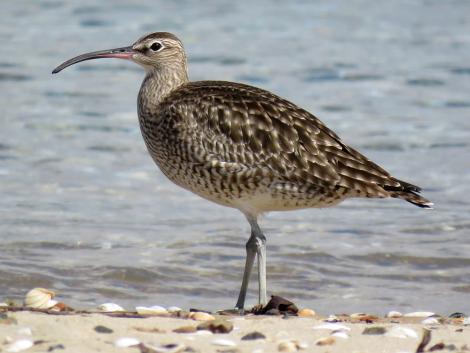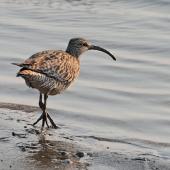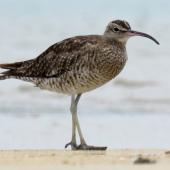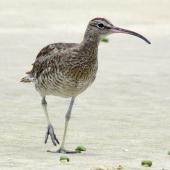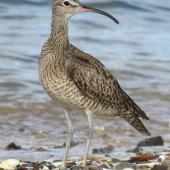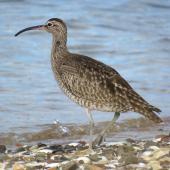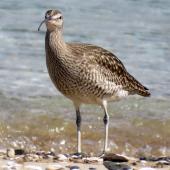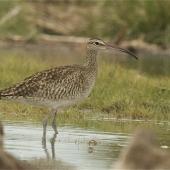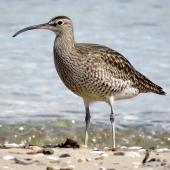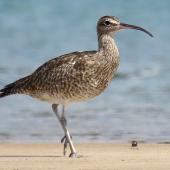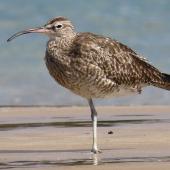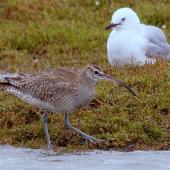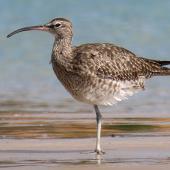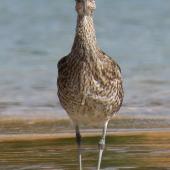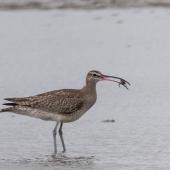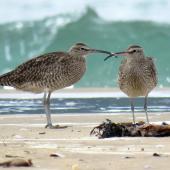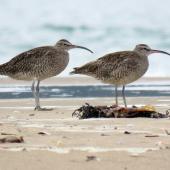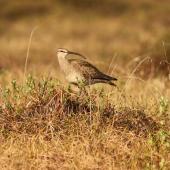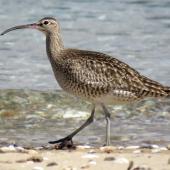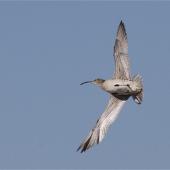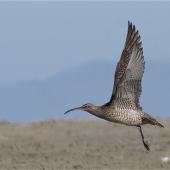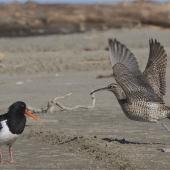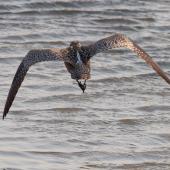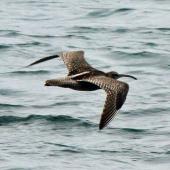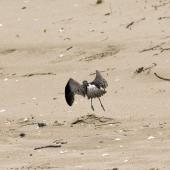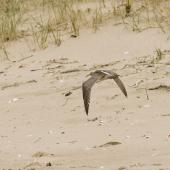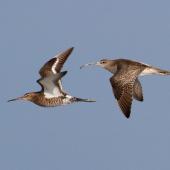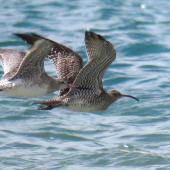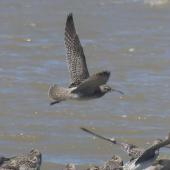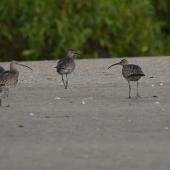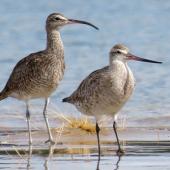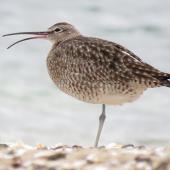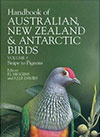Eurasian whimbrel
Numenius phaeopus (Linnaeus, 1758)
Order: Charadriiformes
Family: Scolopacidae
Other names: Asiatic whimbrel
Geographical variation: Up to five subspecies, with the eastern form variegatus the only form reported from New Zealand. Often considered conspecific with American whimbrel (Numenius hudsonicus)
Whimbrels are large shorebirds which migrate to New Zealand from Arctic breeding grounds in small numbers. Most records are during the summer but a few birds occasionally overwinter. In New Zealand they typically associate with bar-tailed godwits, from which they differ in being darker, having a striped head and a strongly down-curved bill.
Identification
Whimbrels are somewhat larger than bar-tailed godwits and recognisable by their down-curved bill and pale stripe down the centre of crown. They are mottled dark brown above, pale below, with much brown streaking on the throat and breast. The head is conspicuously striped, with a pale eyebrow stripe separating the dark eye-stripe and side-crown, and another pale stripe down the centre of the crown. The rump and back pattern is very variable, ranging from largely white with some brown mottling, to heavily streaked brown appearing almost all dark at a distance. Most (possibly all) New Zealand birds are of the Eurasian species, and typically have a pale blaze up the back visible in flight. However, separation of Eurasian and American whimbrels on rump pattern is unreliable as some Eurasian birds from Siberia have completely dark rumps. The underwing pattern of any ‘dark-rumped’ whimbrel should be checked; both forms reported from New Zealand have underwngs heavily barred with brown, but American birds have a cinnamon-buff toned underwing (similar to bristle-thighed curlew) while Asiatic birds have a more greyish tone.
Voice: a distinctive seven note whistle: ti-ti-ti-ti-ti-ti-ti.
Similar species: eastern curlew is larger with proportionately much longer bill and no crown stripe. Little whimbrel has crown stripe but bill is finer and only slightly down curved. Bristle-thighed curlew is similar in size and structure but has overall cinnamon-buff colouration, a plain (unbarred) orange-buff rump, and a very different call. American whimbrel is almost identical, but always has a dark back, and has underwing with buff tones under the barring (cf. grey in Eurasian whimbrel).
Distribution and habitat
Eurasian whimbrels may occur on estuaries throughout New Zealand, but most records are from the northern half of the North Island and Farewell Spit.
Population
About 70 Eurasian whimbrels occur in New Zealand annually. The East Asian-Australasian Flyway population is estimated at 55,000. Numbers are thought to be declining. Eurasian whimbrels have been recorded as vagrant at the Kermadec, Chatham, and Auckland Islands.
Threats and conservation
About 50% of the East Asian-Australasian Flyway Eurasian whimbrel population stages in the Yellow Sea on northward migration – an area under severe threat from reclamation and pollution.
Breeding
Eurasian whimbrels breed on Arctic tundra across Eurasia. A clutch of 4 eggs is laid in a shallow scrape lined with small bits of vegetation.
Behaviour and ecology
In New Zealand, Eurasian whimbrels occur singly or in small flocks on estuaries, often associating with bar-tailed godwits.
Food
In the non-breeding season Eurasian whimbrels feed on a wide range of estuarine invertebrates including worms but particularly crabs. They also take small fish.
Weblinks
http://www.environment.gov.au/cgi-bin/sprat/public/publicspecies.pl?taxon_id=849
References
Barter, M. 2002. Shorebirds of the Yellow Sea: importance, threats and conservation status. Wetlands International Global Series 9.
del Hoyo, J.; Elliott, A.; Sargatal, J. (eds). 1996. Handbook of birds of the world. Vol. 3, hoatzin to auks. Lynx Edicions, Barcelona.
Heather, B.D.; Robertson, H.A. 1996. The field guide to the birds of New Zealand. Viking, Auckland.
Higgins, P.J.; Davies, S.J.J.F. (eds) 1996. Handbook of Australian, New Zealand and Antarctic birds. Vol. 3, snipe to pigeons. Oxford University Press, Melbourne.
Kuang, F.; Wu, W.; Li, D.; Hassell, C.J.; Maglio, G.; Leung, K.-S.K.; Coleman, J.T.; Cheng, C.; Tomkovich, P.S.; Ma, Z. 2022. Detecting the non-breeding region and migration route of whimbrels (Numenius phaeopus rogachevae) in the East Asian-Australasian Flyway. Avian Research 13: 100011 (6 pp.).
MacKinnon, J., Verkuil, Y.I., Murray, N. 2012. IUCN situation analysis on East and Southeast Asian intertidal habitats, with particular reference to the Yellow Sea (including the Bohai Sea). Occasional Paper of the IUCN Species Survival Commission No. 47. IUCN, Gland, Switzerland and Cambridge, UK. 70 p.
Medway, D.G. 2010. Charadriiformes (waders). Pp. 191-223. In: Checklist Committee (OSNZ) 2010. Checklist of the birds of New Zealand, Norfolk and Macquarie Islands, and the Ross Dependency, Antarctica (4th edn). Ornithological Society of New Zealand & Te Papa Press, Wellington.
Sangster, G.; Collinson, J.; Crochet, P-A.; Knox, A.G.; Parkin, D.T.; Svensson, L.; Votier, S.C. 2011. Taxonomic recommendations for British birds: seventh report. Ibis 153: 883-892.
Southey, I. 2009. Numbers of waders in New Zealand 1994-2003. DOC Research & Development Series 308. Department of Conservation; Wellington. 70 p.
Tomkovich, P.S. 2008. A new subspecies of the whimbrel (Numenius phaeopus) from central Siberia. Zooloičeski Žurnal 87: 1092-1099 [in Russian]
Wetlands International (2012). Waterbird population estimates. Fifth Edition. Summary Report. Wetlands International, Wageningen, The Netherlands
Zink, R.M.; Rohwer S.; Andreev, A.V.; Dittmann, D.L. 1995. Trans-Beringia comparisons of mitochondrial DNA differentiation in birds. Condor 97: 639-649.
Recommended citation
Melville, D.S. 2013 [updated 2022]. Eurasian whimbrel. In Miskelly, C.M. (ed.) New Zealand Birds Online. www.nzbirdsonline.org.nz
Eurasian whimbrel
- Breeding season
-
- Jul
- Aug
- Sep
- Oct
- Nov
- Dec
- Jan
- Feb
- Mar
- Apr
- May
- Jun
- Egg laying dates
-
- Jul
- Aug
- Sep
- Oct
- Nov
- Dec
- Jan
- Feb
- Mar
- Apr
- May
- Jun
Asiatic whimbrel
- Breeding season
-
- Jul
- Aug
- Sep
- Oct
- Nov
- Dec
- Jan
- Feb
- Mar
- Apr
- May
- Jun
- Egg laying dates
-
- Jul
- Aug
- Sep
- Oct
- Nov
- Dec
- Jan
- Feb
- Mar
- Apr
- May
- Jun
American whimbrel
- Breeding season
-
- Jul
- Aug
- Sep
- Oct
- Nov
- Dec
- Jan
- Feb
- Mar
- Apr
- May
- Jun
- Egg laying dates
-
- Jul
- Aug
- Sep
- Oct
- Nov
- Dec
- Jan
- Feb
- Mar
- Apr
- May
- Jun




